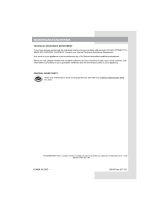
340670
• Install the appliance as specifi ed in the instruction manual.
• Do not open the appliance cover ore often than necessary.
• In models with condenser units on the back wall of the appliance, check occasionally to make
sure that air circulation behind the appliance is indeed unobstructed and that the condenser unit
is always clean (see section “Troubleshooting”).
• If the gasket is damaged or does not provide a perfect seal for other reasons, have it replaced as
soon as possible.
• Before placing the food in the appliance, cool them to room temperature.
• We recommend defrosting and cleaning the appliance once to twice a year.
• Do not open the cover more often than necessary. Frequent opening will increase the
temperature in the chest, excessive formation of frost, and thus higher power consumption.
• Do not keep the chest open too long. This is particularly important when the weather is hot and humid.
• Every failure to heed the instructions in the sections “Installing the appliance” and “Saving
power” may lead to higher power consumption.
• For models with the condenser unit installed in the insulation layer, allow free circulation of air at
the front side of the appliance as well.
• If the appliance was bought to replace an old, obsolete appliance with a locking mechanism that
cannot be opened from the inside of the appliance (lock, latch), disable the locking mechanism.
This will reduce the danger to children and protect them from the threat of suffocation.
• Connect the appliance to the power mains in accordance with relevant instructions and regulations.
• Do not touch the cool surfaces during appliance operation, particularly if your hands are moist or
wet, as your skin may freeze, or stick, to these surfaces.
• Do not freeze beverages in bottles. This applies in particular to carbonated beverages such
as mineral water, sparkling wine, beer, soft drinks etc.; in the process of freezing, the fl uid will
expand and the glass may break.
• Do not eat frozen food (bread, fruit, vegetables) as there is danger of frostbite.
• If the smell or colour of any food looks suspicious, discard the food as it may be hazardous to eat.
• Do not use electric devices to defrost the appliance (hair drier etc.) and do not remove frost or
ice using sharp tools; only use the accessories supplied by the manufacturer.
• The appliance contains a refrigerant and oil. Therefore, a damaged appliance must be disposed
of in compliance ecological requirements.
• The rating plate with basic information on the appliance in located in the appliance interior or
on the back wall. If the language on the rating plate is not the language of your choice or the
language of your country, replace it with the one supplied.
• An obsolete appliance should be immediately put out of use.
• To protect the environment, be careful not to damage the parts of the cooling system located on
the back wall, in the compressor unit compartment or in the insulation layer. Cooling system in
the insulation layer can also be damaged if the exterior or interior walls are pierced.
• Appliance interior equipment may change according to the appliance model.
5
Advice for saving power
Important warnings
















